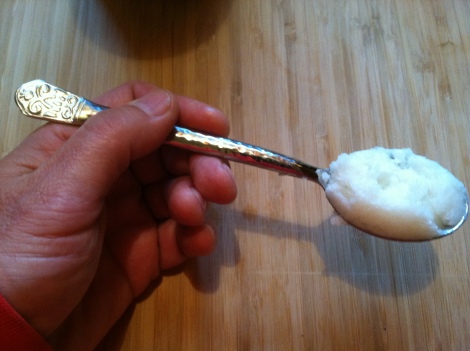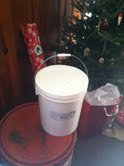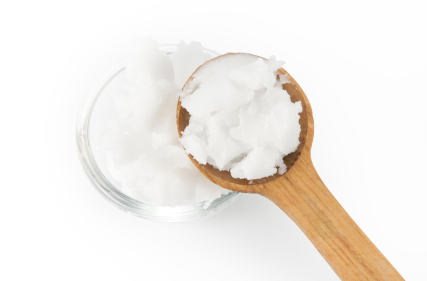160 Uses for Coconut Oil

Source: Wake Up World
By Jennifer
Hybrid Rasta Mama
Coconut Oil – An Overview
Offering a myriad of health benefits, coconut oil is affordable, readily available and completely natural. I use it for EVERYTHING. Literally. I buy it in 5 gallon increments and keep it all over my house. I even have some in the car. So here is a little information to inspire you to check out this amazing oil!
Coconut Oil Is:
- Anti-bacterial (kills bacteria that cause ulcers, throat infections, urinary tract infections, gum diseases, and other bacterial infections)
- Anti-carcinogenic (coconut oil has antimicrobial properties so it effectively prevents the spread of cancer cells and enhances the immune system)
- Anti-fungal (kills fungi and yeast that lead to infection)
- Anti-inflammatory (appears to have a direct effect in suppressing inflammation and repairing tissue, and it may also contribute by inhibiting harmful intestinal microorganisms that cause chronic inflammation.)
-
Anti-microbial/Infection Fighting (the medium-chain fatty acids and monoglycerides found in coconut oil are the same as those in human mother’s milk, and they have extraordinary antimicrobial properties. By disrupting the lipid structures of microbes, they inactivate them. About half of coconut oil consists of lauric acid. Lauric acid, its metabolite monolaurin and other fatty acids in coconut oil are known to protect against infection from bacteria, viruses, yeast, fungi and parasites. While not having any negative effect on beneficial gut bacteria, coconut oil inactivates undesirable microbes.)
- An Antioxidant (protects against free-radical formation and damage)
- Anti-parasitic (fights to rid the body of tapeworms, lice and other parasites)
- Anti-protozoa (kills giardia, a common protozoan infection of the gut)
- Anti-retroviral (kills HIV and HLTV-1)
- Anti-viral (kills viruses that cause influenza, herpes, measles, hepatitis C, SARS, AIDS, and other viruses)
- Infection fighting
- Has no harmful for discomforting side effects
- Known to improve nutrient absorption (easily digestible; makes vitamins and minerals more available to the body)
- Nontoxic to humans and animals
Daily Dosage:
Here is a chart outlining the recommended daily dosage of virgin coconut oil for persons over the age of 12. Coconut oil may be consumed by children under 12 but it is advisable to check with a healthcare practitioner on the proper dosage. Any good naturopath will have the information at the ready. (Starting at 12 months of age, I gave my daughter one teaspoon per day and she weighed about 16 pounds at that time.)
| Weight in pounds/kilograms |
Number of tablespoons of coconut oil daily |
| 175+/79+ |
4 |
| 150+ /68+ |
3 1/2 |
| 125+ / 57+ |
3 |
| 100+/ 45+ |
2 1/2 |
| 75+ / 34+ |
2 |
| 50+ / 23+ |
1 1/2 |
| 25+ / 11+ |
1 |
Type of Coconut Oil to Use:
- Virgin (unrefined) coconut oil tastes and smells coconutty and is great for cooking and baking where you want that flavor. You can use it for anything but it will impart a coconut taste (mild) and odor (pleasant in my book)! Unrefined coconut oil retains the most nutritional value and is superior to refined oil.
- Expeller pressed (refined) coconut oil can be used for anything. It does not have a coconutty smell or taste. It is still outstanding to use but does lose some of it’s health properties during the refining process.
- Food grade should always be used.
160 Uses for Coconut Oil
Coconut Oil for Personal Hygiene/Body
1. Age Spots (also known as liver spots) – applying coconut oil directly to the age spot will help it fade.
2. After Shave – coconut oil will help heal your skin after shaving without clogging pores. Great for razor burn!
3. Baldness – apply three times a day to affected area of hair loss. Coconut oil supports cell regeneration.
4. Birth Marks – can be used after a laser removal treatment to aid in healing. Can also be applied after an apple cider vinegar treatment to help support and aid the fading process.
5. Body Scrub – mix coconut oil and sugar together and rub all over! Rinse off and your skin will be super soft! You can add in essential oils if you would like a specific smell.
6. Bruises – applied directly to the bruise, coconut oil enhances the healing process by reducing swelling and redness.
7. Bug Bites – when applied directly to a bug bite, coconut oil can stop the itching and burning sensation as well as hasten the healing process.
8. Burns – apply to burn site immediately and continue applying until healed. Will reduce the chances of permanent scarring and promotes healing.
9. Chapstick – just rub a little into lips and it not only acts as a softening agent but it also has an SPF of about 4 so you get a little protection!
10. Cradle Cap – having issues with dry skin on your baby’s scalp? Coconut oil will not only nourish your baby’s skin, it also helps eliminate cradle cap. Just rub a teaspoon onto scalp daily.
11. Dandruff – coconut oil soaks into the scalp moisturizing dry skin and relieves symptoms of dandruff. It also helps to control oil secretion from the scalp, another leading cause of dandruff.
12. Deodorant – coconut oil alone can be used as a deodorant, but even more effective in combination with cornstarch/arrowroot powder and baking soda!
13. Diaper Salve – very comforting on a rashy bum with no harsh chemicals. Also safe for cloth diapers.
14. Exfoliator – coconut oil mixed with sugar or sea salt is a very nourishing and effective exfoliator and safe to use all over the body.
15. Eye cream – apply under the eyes to reduce puffiness, bags and wrinkles. Use on the lids in the evening.
16. Face Wash/ Soap – mix equal parts coconut oil with olive oil, almond oil, avocado oil and castor oil and use in place of soap when washing your face. Wet face, rub oil in and leave on for two minutes, rinse and pat dry. One teaspoon should be adequate.
17. Hair conditioner/ Deep Treatment – use as a leave-in hair conditioner by applying a teaspoon of coconut oil to your ends and then running your fingers through your hair to distribute the rest! For a deeper treatment, rub in a tablespoon of coconut oil onto your dry scalp and gently work through to the ends. Put a shower cap on to prevent transfer onto bed linens and leave on overnight.
18. Hair Gel/ Defrizzer – rub a little between your palms and either scrunch into hair (for curly hair) or finger comb in through from scalp to ends (for wavy/straight hair).
19. Healing – when applied on scrapes and cuts, coconut oil forms a thin, chemical layer which protects the wound from outside dust, bacteria and virus. Coconut oil speeds up the healing process of bruises by repairing damaged tissues. Plus, it smells a heck-of-a-lot better than anything from the pharmacy.
20. Lubricant – it is an all-natural, perfectly safe personal lubricant. Not compatible with latex!
21. Makeup Remover – use a cotton swab and a dab of coconut oil and you would be amazed at how well it works!
22. Massage Oil – pretty simple; grab some and rub!
23. Moisturizer – simply scoop some out of the jar and apply all over your body, including neck and face.
24. Mole Remover – when applied after an apple cider vinegar compress for several weeks, moles have been known to “slide off” or just disappear.
25. Nipple Cream – works great to nourish cracked, sore or dry nipples. Apply to a cotton ball and leave on your nipples between feedings.
26. Oily Skin Fix – prone to oily skin or an oily T-zone? Use a pea sized amount underneath makeup or alone to reduce the appearance of oil.
27. Pre Shampoo Treatment for Hair – rub a little into scalp and hair before shampooing. This is especially useful for those with course or frizzy hair.
28. Pre-Shave – coconut oil will prep skin for the pending damage caused by shaving.
29. Skin Problems – coconut oil relieves skin problems such as psoriasis, dermatitis, and eczema.
30. Stretch Mark Cream – coconut oil is great at nourishing damaged skin. It may not be the magic stretch mark cure but it will help.
31. Sun Burn Relief – rub liberal amounts of coconut oil into the affected area.
32. Sunscreen – see my post on natural sunscreen for more detailed information.
33. Swimmers Ear – mix garlic oil and coconut oil and put a few drops in affected ear for about 10 minutes. Do this 2-3 times a day and it usually works within one or two days.
34. Tattoo Healing and Moisturizer – continued use of coconut oil on tattoos will help keep the pigment from fading. Used on new tattoos, coconut will hasten the healing process and decrease the chance of infection.
35. Toothpaste – there are numerous recipes out there but I just mix coconut oil and baking soda and dab a little of the mix on my toothbrush.
36. Wrinkle Prevention and Wrinkle Reducer – rubbing coconut oil on winkles and sagging skin helps strengthen the connective tissues to bring back that youthful look!
Coconut Oil for General Health and Wellness
37. Breastfeeding – for breastfeeding moms, consuming 3 ½ tablespoons of coconut oil daily will enrich the milk supply.
38. Bones and Teeth – coconut oil aids in the absorption of calcium and magnesium leading to better development of bones and teeth.
39. Digestion – the saturated fats in coconut oil help control parasites and fungi that cause indigestion and other digestion related problems such as irritable bowel syndrome. The fat in coconut oil also aids in the absorption of vitamins, minerals and amino acids, making you healthier all around.
40. Energy Boost – coconut oil boosts energy and endurance making it a great supplement for athletes as well as those needed a quick pick me up.
41. Fitness – coconut oil has been proven to stimulate your metabolism, improve thyroid function, and escalate energy levels, all of which help decrease your unwanted fat while increasing muscle.
42. Improves insulin secretion and utilization of blood glucose making it great for both diabetics and non-diabetic.
43. Lung Function – increases the fluidity of cell surfaces.
44. Nausea – rub some coconut oil on the inside for the wrist and forearm to calm an upset stomach.
45. Nose bleeds – coconut oil can prevent nose bleeding that is caused by sensitivity to weather such as extreme heat and extreme cold. This condition happens when the nasal passages become dry because of cold or dry air resulting to burns and cracks in the mucus membranes so bleeding happens. To prevent this just put coconut oil in you nostrils. Coat your finger with coconut oil and then lie down and coat your finger inside your nose. Doing this will strengthen and protect the capillaries in the nasal passages. A Vitamin C supplement will also help prevent nose bleeding.
46. Oil pulling with coconut oil offers a two for one health benefit!
47. Stress Relief – relieve mental fatigue by applying coconut oil to the head in a circular, massaging motion. The natural aroma of coconuts is extremely soothing thus helping to lower your stress level.
48. Vitamin and nutrient absorption
49. Weight loss – the saturated fats contribute to weight loss and controlling cravings. Also increases metabolic rate.
Coconut Oil for Health Problems (when taken internally it is known for aiding, preventing, relieving or even curing these health issues)
50. Acid reflux/indigestion aid if taken after a meal
51. Adrenal fatigue
52. Allergies (seasonal hay fever)
53. Alzheimer’s/Dementia
54. Asthma, even in children
55. Autism
56. Bowel function
57. Bronchial Infections
58. Cancer (has been shown to prevent colon and breast cancer in laboratory tests)
59. Candida Albicans
60. Cholesterol – improves HDL (‘good’ cholesterol) to LDL (‘bad’ cholesterol) ratio in people with high cholesterol
61. Chronic Fatigue
62. Crohns Disease and resulting inflammation
63. Circulation/feeling cold all the time
64. Colds and Flus
65. Constipation
66. Cystic Fibrosis
67. Depression
68. Diabetes – helps keep blood sugar levels stable and/or helps with cravings
69. Dysentery
70. Eczema – in addition to taking it internally, many have success applying it externally, but some don’t
71. Edema
72. Energy boost
73. Epilepsy (known to reduce epileptic seizures)
74. Fever Support
75. Flaky, Dry Skin
76. Gallbladder disease and pain
77. Gas
78. H. pylori
79. Head Lice
80. Heart Disease (protects arteries from injury that causes atherosclerosis)
81. Hemorrhoids (can applied externally or internally twice a day)
82. HIV
83. Hot Flashes
84. Hyperthyroidism
85. Immune System Builder
86. Irritable Bowel Syndrome
87. Jaundice
88. Kidney Disease
89. Kidney Stones (aids in dissolving them)
90. Liver Disease
91. Lung Disease
92. Malnutrition
93. Mental Clarity
94. Menstruation Relief regarding pain/cramps and heavy blood flow
95. Migraines (with regular use)
96. Mononucleosis
97. Osteoporosis
98. Pancreatitis
99. Parasites
100. Periodontal Disease and tooth decay
101. Prostate Enlargement (benign prostatic hyperplasia)
102. Rickets
103. Skin problems
104. Scurvy
105. Stomach Ulcers
106. Toenail fungus
107. Thrush
108. Thyroid Function (regulates an overactive or underactive thyroid)
109. Ulcerative Colitis
110. Underactive thyroid gland – results have shown subsequent thyroid blood tests becoming normal after ingesting coconut oil daily
111. Urinary Tract Infections (Bladder Infections)
Coconut Oil and Health Problems (when applied topically it is known for aiding, relieving, or even curing these health issues)
112. Acne
113. Allergies/Hay Fever – rub a little inside the nostrils for quick relief. The pollen will cling to the oil.
114. Athletes foot
115. Back pain/sore muscles
116. Boils and cysts
117. Canker sores
118. Cellulite
119. Circumcision healing – although I am personally against circumcision, I have read that coconut oil is a really great healer for this.
120. Decongestant – rub coconut oil on the chest and under the nose when congested from a cold or allergies
121. Ear infection – place a few drops inside the ear twice daily for relief from pain. Also fights the infection itself.
122. Genital Warts (through topical application over 6 weeks, and coconut oil enemas twice a day depending on the location of the warts)
123. Gum Disease and Gingivitis (use as a toothpaste or rub directly on gums)
124.Herpes (applied topically and taken internally)
125.Hives (reduces the itch and swelling
126. Pink eye (applied around and in the eye)
127. Ringworm
128. Toothache
129. Warts
Coconut Oil and Cooking
130. Butter Substitute – use 1 cup to 1 cup ratio when replacing butter in recipes with coconut oil.
131. Nutritional Supplement – melt and add to smoothies.
132. Replacement for butter/lard/Crisco/PAM in its solid form for greasing pans, pie crusts, etc.
133. Replacement for various oils in liquid form – baking, cooking, sautéing, etc.
Coconut Oil and Pets/Animals
Check with your veterinarian but the recommended dosage for animals is 1/4 teaspoon for every 10 pounds of body weight twice daily.
134. Aids healing of digestive disorders like inflammatory bowel syndrome and colitis
135. Aids in arthritis or ligament problems
136. Aids in elimination of hairballs and coughing
137. Applied topically, promotes the healing of cuts, wounds, hot spots, dry skin and hair, bites and stings
138. Clears up skin conditions such as eczema, flea allergies, contact dermatitis, and itchy skin
139. Disinfects cuts and promotes wound healing
140. Great for dogs and cats for general wellness. Just add a teaspoon to their water bowl daily.
141. Helps prevent or control diabetes
142. Helps sedentary dogs feel energetic
143. Helps reduce weight, increases energy
144. Improves digestion and nutrient absorption
145. Makes coats become sleek and glossy, and deodorizes doggy odor
146. Medium-chain triglycerides (MCTs) have been shown to improve brain energy metabolism and decrease the amyloid protein buildup that results in brain lesions in older dogs.
147. Prevents and treats yeast and fungal infections, including candida
148. Reduces allergic reactions and improves skin health
149. Reduces or eliminates bad breath in dogs
150. Regulates and balance insulin and promotes normal thyroid function
Other Uses for Coconut Oil
151. Chewing Gum in Hair Remover – just rub some coconut oil over the stuck chewing gum, leave in for about 30 minutes, then roll the gum between your fingertip. Voila! It’s out!
152. Goo Gone – just mix equal parts coconut oil and baking soda into a paste. Apply to the “sticky” area and let it set for a minute. Then scrub off with an old toothbrush or the scrubby side of a sponge.
153. Insect repellent – mix coconut oil with peppermint oil extract and rub it all over exposed skin. Keeps insects off better than anything with DEET! Tons safer too.
154. Moisturizing and cleaning leather products
155. Oiling wood cutting boards and wood bowls
156. Polishing Bronze – all you have to do is rub a little oil into a cotton towel and then wipe down the statue. It cleans and helps deepen the color of your bronze.
157. Polish Furniture – coconut oil with a little bit of lemon juice to polish wood furniture. However, I recommend you test it first on a very small, unobtrusive part of your furniture to make sure it works the way you’d like.
158. Seasoning animal hide drums
159. Seasoning cookware
160. Soap making – coconut oil can be used as one of the fats in soap.
Did I miss any? Do you use coconut oil for something not on my list? Please add it in the comments. I am always excited to find new ways to implement coconut oil!
I have also written several other posts about coconut oil that you may be interested in reading. A few are listed here but please check my Coconut Health page regularly as I update that with my twice monthly posts related to coconut oil:
• Coconut Oil Unleashed – Reader Questions Answered
• Coconut Oil for Digestive Disorders
• Coconut and Pregnancy (coconut products in general are discussed)
• Eating Traditional Foods and The Blood Type Diet (coconut oil is
discussed in this post but not the focus)
• Let’s Talk About Fats Baby! (discusses coconut oil as a healthy
source of fat in your diet)
• Nipples, Lady Bits, Coconut Oil – Oh My!
Interested in purchasing coconut oil? Check out my resources page to find out what brands I love!
You can also check out these books for further information on coconut oil:
• Virgin Coconut Oil by Brian and Marianita Shilhavy
• Eat Fat Lose Fat: The Healthy Alternative to Trans Fats by Mary Enig, PhD, and Sally Fallon
• The Coconut Oil Miracle Revised and Coconut Cures both by Bruce Fife.
Until next time…I am aiming for 200 Uses For Coconut Oil!
Yours In Coconut Health, Jennifer
This article was discovered at ybertaud9.wordpress.com – We highly recommend checking out this very informative site.























